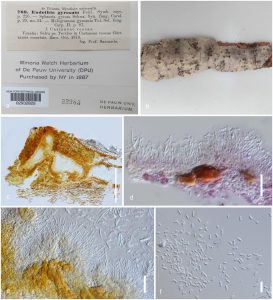Endothia gyrosa (Schwein.) Berk. [as‘gyrosum’], Outl. Brit. Fung. (London): 384 (1860).
Pathogenic forming cankers. Sexual morph: Stromata 1.5–2 mm high, 1–2 mm diam., irregularly spaced on the surface of dead bark, orange when wet. Ascomata 250–300 μm diam., perithecia, deeply embedded in the same or similar stromata producing pycnidia, globose, with slightly protruding black necks. Necks 400–500 μm long, 100–120 μm diam., Asci 8-spored, unitunicate, cylindrical, with short pedicel. Ascospores 6–10 × 2–2.5 μm, non-septate, allantoid with tapering ends, hyaline. Asexual morph: Conidiomata 385 × 150 lm, pycnidia, embedded in the stromatal tissue, spore tendrils are not formed, irregularly shaped. Conidiophores 5–10 × 1–2 μm (x̅ = 8 × 1.5 μm , n = 20), cylindrical to irregular, tightly packed, hyaline. Conidiogenous cells 8–12 × 1–2 μm , cylindrical, hyaline, narrowing towards the apex. Conidia 3–4 × 1 μm , rodshaped,
hyaline, unicellular, smooth (description based on Snow et al. 1975).
Material examined: ITALY, Selva, Treviso, Venice, on bark of Castaneae vascae L. (Fagaceae), 1876, P. A. Saccardo s. n., NY 2932825.
Notes: Endothia was introduced based on Sphaeria gyrosa Schwein., later renamed as Endothia gyrosa. Endothia gyrosa causes a serious canker disease of Liquidambar formosana Hence (Snow et al. 1975). Endothia species cause hobnail canker on oak (Van Arsdel 1972). Some studies suggest that Endothia is a weak wound pathogen and more recent studies have shown Endothia species to cause serious disease of Quercus species (Stipes and Phipps 1971; Van Arsdel 1972).
Fig. Endothia gyrosa (NY 2932825). a Packet of herbarium. b Herbarium specimen. c Cross section of conidiomata. d Stromatic tissues turn to purple with KOH. e Conidiogenous cells, conidia. f Conidia. Scale bars: c = 200 μm , d–f = 10 μm.

